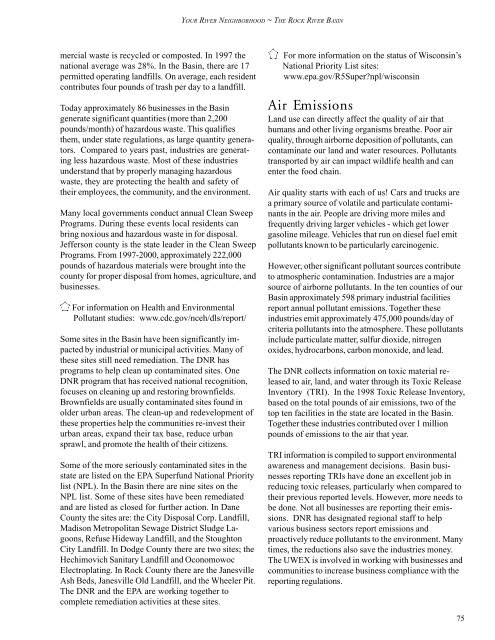Cities (PDF, 295KB) - Wisconsin Department of Natural Resources
Cities (PDF, 295KB) - Wisconsin Department of Natural Resources
Cities (PDF, 295KB) - Wisconsin Department of Natural Resources
You also want an ePaper? Increase the reach of your titles
YUMPU automatically turns print PDFs into web optimized ePapers that Google loves.
YOUR RIVER NEIGHBORHOOD ~ THE ROCK RIVER BASIN<br />
mercial waste is recycled or composted. In 1997 the<br />
national average was 28%. In the Basin, there are 17<br />
permitted operating landfills. On average, each resident<br />
contributes four pounds <strong>of</strong> trash per day to a landfill.<br />
Today approximately 86 businesses in the Basin<br />
generate significant quantities (more than 2,200<br />
pounds/month) <strong>of</strong> hazardous waste. This qualifies<br />
them, under state regulations, as large quantity generators.<br />
Compared to years past, industries are generating<br />
less hazardous waste. Most <strong>of</strong> these industries<br />
understand that by properly managing hazardous<br />
waste, they are protecting the health and safety <strong>of</strong><br />
their employees, the community, and the environment.<br />
Many local governments conduct annual Clean Sweep<br />
Programs. During these events local residents can<br />
bring noxious and hazardous waste in for disposal.<br />
Jefferson county is the state leader in the Clean Sweep<br />
Programs. From 1997-2000, approximately 222,000<br />
pounds <strong>of</strong> hazardous materials were brought into the<br />
county for proper disposal from homes, agriculture, and<br />
businesses.<br />
For information on Health and Environmental<br />
Pollutant studies: www.cdc.gov/nceh/dls/report/<br />
Some sites in the Basin have been significantly impacted<br />
by industrial or municipal activities. Many <strong>of</strong><br />
these sites still need remediation. The DNR has<br />
programs to help clean up contaminated sites. One<br />
DNR program that has received national recognition,<br />
focuses on cleaning up and restoring brownfields.<br />
Brownfields are usually contaminated sites found in<br />
older urban areas. The clean-up and redevelopment <strong>of</strong><br />
these properties help the communities re-invest their<br />
urban areas, expand their tax base, reduce urban<br />
sprawl, and promote the health <strong>of</strong> their citizens.<br />
Some <strong>of</strong> the more seriously contaminated sites in the<br />
state are listed on the EPA Superfund National Priority<br />
list (NPL). In the Basin there are nine sites on the<br />
NPL list. Some <strong>of</strong> these sites have been remediated<br />
and are listed as closed for further action. In Dane<br />
County the sites are: the City Disposal Corp. Landfill,<br />
Madison Metropolitan Sewage District Sludge Lagoons,<br />
Refuse Hideway Landfill, and the Stoughton<br />
City Landfill. In Dodge County there are two sites; the<br />
Hechimovich Sanitary Landfill and Oconomowoc<br />
Electroplating. In Rock County there are the Janesville<br />
Ash Beds, Janesville Old Landfill, and the Wheeler Pit.<br />
The DNR and the EPA are working together to<br />
complete remediation activities at these sites.<br />
For more information on the status <strong>of</strong> <strong>Wisconsin</strong>’s<br />
National Priority List sites:<br />
www.epa.gov/R5Super?npl/wisconsin<br />
Air Emissions<br />
Land use can directly affect the quality <strong>of</strong> air that<br />
humans and other living organisms breathe. Poor air<br />
quality, through airborne deposition <strong>of</strong> pollutants, can<br />
contaminate our land and water resources. Pollutants<br />
transported by air can impact wildlife health and can<br />
enter the food chain.<br />
Air quality starts with each <strong>of</strong> us! Cars and trucks are<br />
a primary source <strong>of</strong> volatile and particulate contaminants<br />
in the air. People are driving more miles and<br />
frequently driving larger vehicles - which get lower<br />
gasoline mileage. Vehicles that run on diesel fuel emit<br />
pollutants known to be particularly carcinogenic.<br />
However, other significant pollutant sources contribute<br />
to atmospheric contamination. Industries are a major<br />
source <strong>of</strong> airborne pollutants. In the ten counties <strong>of</strong> our<br />
Basin approximately 598 primary industrial facilities<br />
report annual pollutant emissions. Together these<br />
industries emit approximately 475,000 pounds/day <strong>of</strong><br />
criteria pollutants into the atmosphere. These pollutants<br />
include particulate matter, sulfur dioxide, nitrogen<br />
oxides, hydrocarbons, carbon monoxide, and lead.<br />
The DNR collects information on toxic material released<br />
to air, land, and water through its Toxic Release<br />
Inventory (TRI). In the 1998 Toxic Release Inventory,<br />
based on the total pounds <strong>of</strong> air emissions, two <strong>of</strong> the<br />
top ten facilities in the state are located in the Basin.<br />
Together these industries contributed over 1 million<br />
pounds <strong>of</strong> emissions to the air that year.<br />
TRI information is compiled to support environmental<br />
awareness and management decisions. Basin businesses<br />
reporting TRIs have done an excellent job in<br />
reducing toxic releases, particularly when compared to<br />
their previous reported levels. However, more needs to<br />
be done. Not all businesses are reporting their emissions.<br />
DNR has designated regional staff to help<br />
various business sectors report emissions and<br />
proactively reduce pollutants to the environment. Many<br />
times, the reductions also save the industries money.<br />
The UWEX is involved in working with businesses and<br />
communities to increase business compliance with the<br />
reporting regulations.<br />
75



![Nature program winter schedule [PDF] - Wisconsin DNR](https://img.yumpu.com/22471254/1/190x245/nature-program-winter-schedule-pdf-wisconsin-dnr.jpg?quality=85)
![City of Middleton [PDF] - Wisconsin Department of Natural Resources](https://img.yumpu.com/22300392/1/190x245/city-of-middleton-pdf-wisconsin-department-of-natural-resources.jpg?quality=85)

![Wetland Conservation Activities [PDF] - Wisconsin Department of ...](https://img.yumpu.com/21975633/1/190x245/wetland-conservation-activities-pdf-wisconsin-department-of-.jpg?quality=85)




![Baraboo River Region[PDF] - Wisconsin Department of Natural ...](https://img.yumpu.com/21975619/1/190x245/baraboo-river-regionpdf-wisconsin-department-of-natural-.jpg?quality=85)




